Artists at Work: Alison Saar
by Vanessa Holyoak
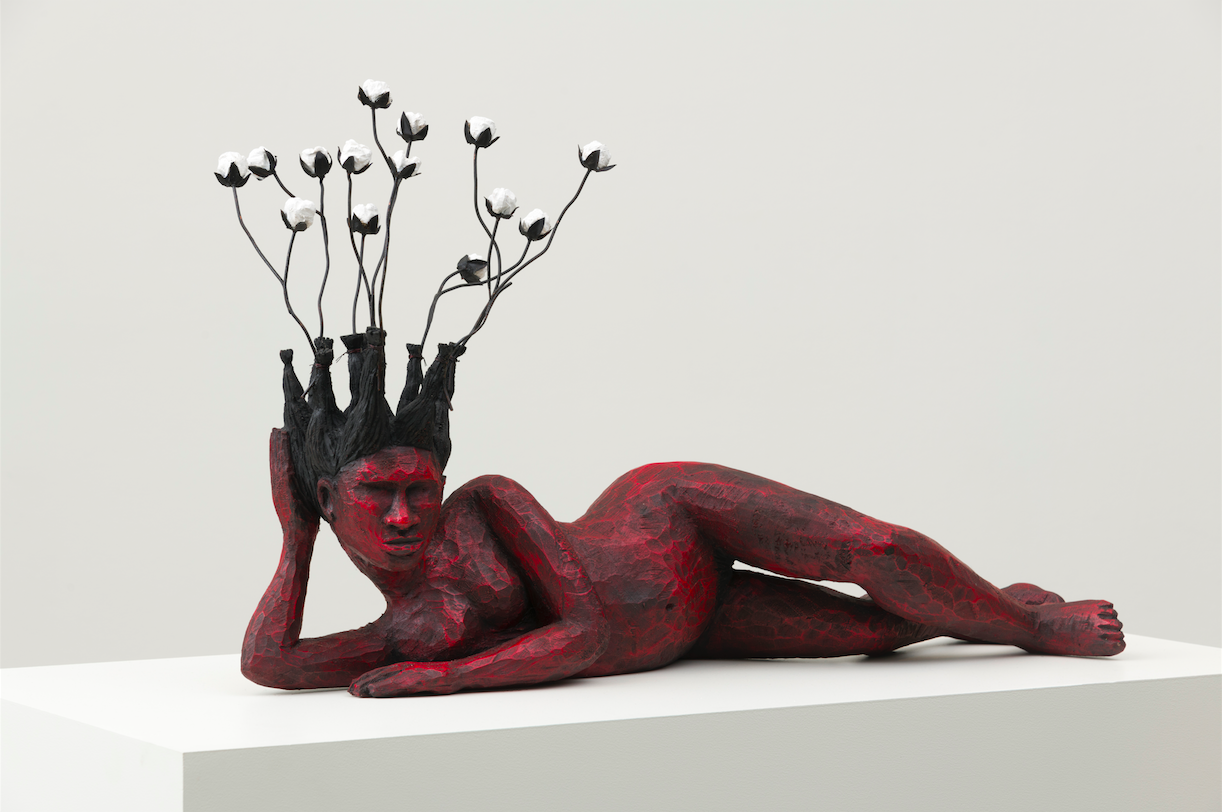
Alison Saar, Bitter Crop, 2018. Wood, steel, bronze, acrylic, tar. 18 x 28 x 8 in. (45.7 x 71.1 x 20.3 cm). Collection of Gary and Kathi Cypres. Courtesy of the Benton Museum of Art at Pomona College.
Raised by a family of artists, Alison Saar has been crafting unique sculptures, installations, prints, and assemblages since her early years, studying at Scripps College (BA 1978) and Otis College of Art and Design (MFA 1981). In 1983, she moved to New York City as an Artist-in-Residence at the Studio Museum in Harlem before returning to Los Angeles and her native Laurel Canyon. Her ethereal body of work often incorporates found objects, weaving together historically rich narratives and symbolism from African diasporic traditions and diverse mythologies ranging from Yoruba to Greek. In 2021, Saar was announced as a participant in the forthcoming Destination Crenshaw art corridor. She also curated her first group exhibition, SeenUNSeen, at L.A. Louver, and was the subject of a two-venue solo exhibition, Of Aether and Earthe, on view at the Armory Center for the Arts and Pomona College’s Benton Museum. The following conversation explores art practices that merge the mystical and political, motherhood, spirit guides, diasporic mythologies, and the role of magic in bringing about cultural healing, benevolence, and transformation.
Vanessa Holyoak: Your work has been featured in a number of exhibitions in the Los Angeles area over the past few months, including your first curatorial project, SeenUNseen, at L.A. Louver, which brought together 10 artists around the idea of “spirit portraiture” and making visible the invisible. You were also the subject of a solo exhibition, Of Aether and Earthe, featured at the Armory Center in Pasadena and the Benton Museum at Pomona College. SeenUNseen features some of your own work, too. Given the overlap, could you speak to any throughlines you see between these concurrent exhibitions, and how your own work might have informed the curatorial choices you made in SeenUNseen?
Alison Saar: Of Aether and Earthe was supposed to have happened in 2020, but because of COVID it was delayed, so they weren’t necessarily planned to happen all at the same time. But I was thankful that they were able to carry Of Aether and Earthe over to 2021, when we could actually have people inside the museums. My work is always looking at the intersection of the real/material world and the spirit world, and I have a real, visceral connection to art that deals with these themes. So, L.A. Louver asked me if I’d be interested in curating a show; I’d never really done that before. Basically, I curated a show of work that I like and it just happened that they all kind of fit together under this theme and title of SeenUNseen. It’s interesting that it parallels with Black Lives Matter and this sort of increased visibility of what has, up until this point, been largely unseen—both the visibility of Black and brown bodies, but also the visibility of racism that is consistent here and has been an eye opener for us all. Many of us were aware of it, but with the tools of surveillance in our own hands we’re able to actually have proof—these images that cannot be denied. So, there’s this kind of funny overlap with that.
Quite a few of the artists are of disparate traditions—Rina Banerjee from India, JOJO ABOT, Keisha Scarville, and Arthur Simms are all of the African diaspora, and Ricardo Vicente José Ruíz is indigenous Mexican-American. I think that is really part of their reality, the notion that there’s always this spirit component to our life, the here and now, and that there’s a constant crossover. I was interested in having a show that dealt with that work, putting them all in the room together and seeing what happened. I was excited because it became this really charged space. It had this curious energy. These conversations between materials and methods of the different artists involved got me excited thinking about what could follow.
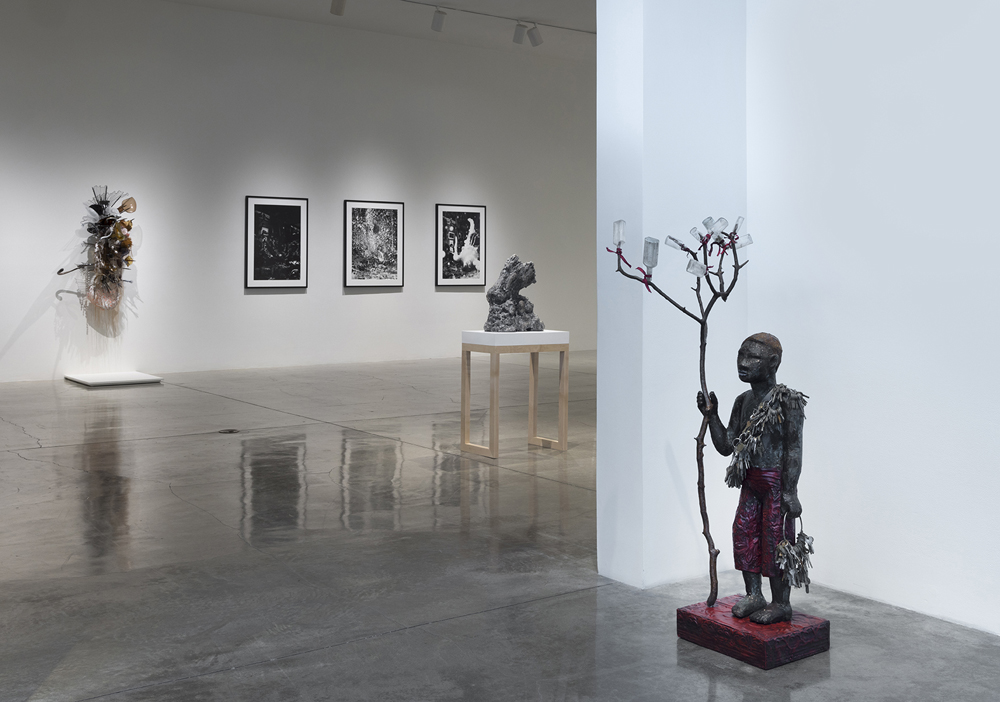
Installation view of SeenUNseen, curated by Alison Saar, L.A. Louver, November 11, 2021 – January 9, 2022. Courtesy of L.A. Louver, Venice, CA.
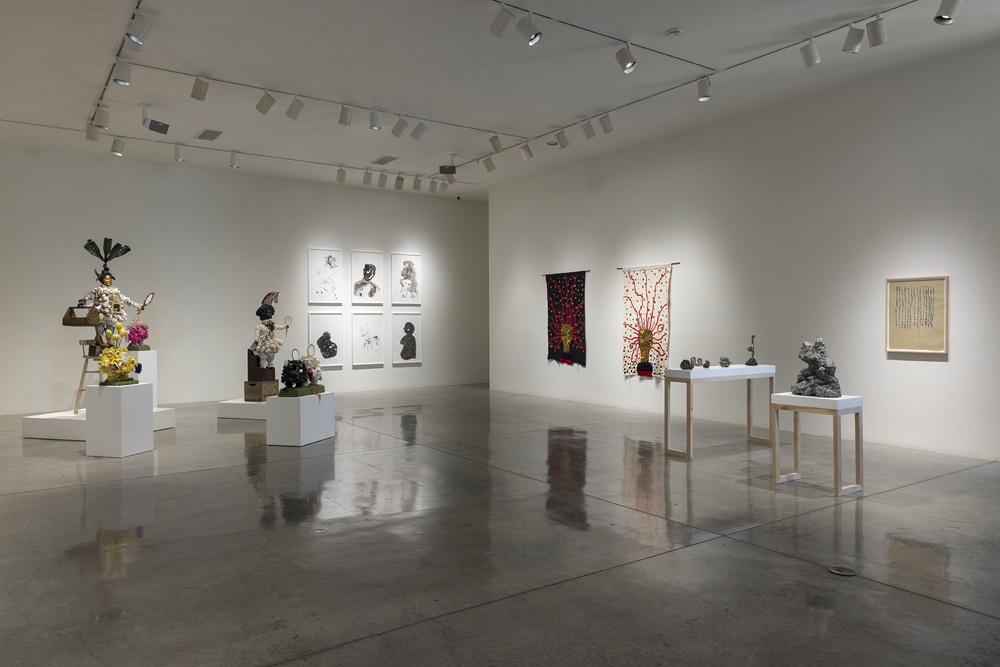
Installation view of SeenUNseen, curated by Alison Saar, L.A. Louver, November 11, 2021 – January 9, 2022. Courtesy of L.A. Louver, Venice, CA
VH: In both your own work and much of the work included in SeenUNseen, there is a dream-like sensibility that almost registers first on a subconscious level. Many of the female figures depicted in your sculptures present as apparitions that have come to bear a message, as if in a dream, especially in the Beckoning installation. We might not decode the message she’s bearing instantaneously, but if you sit with the imagery the message might slowly reveal itself. In some ways, the artist’s task is to imagine these other worlds and then translate their experience to the viewer, who then can interpret that message in their own way. Do you relate to this idea of message bearers in your work?
AS: Most definitely. If you look at gods and deities, transatlantic spirits, perhaps the most important would be Elegua, these messengers who are basically the equivalent of Hermes. The little boy statue placed at the front of the gallery is called Condūcere, which is like “the conduit,” so it’s like this live wire that will connect you. I like the idea because conduits and wiring are so part of our world now in terms of internet and social media, but I also like that it talks about these spirits that can plug you into other places and other worlds.
Curating my own work into the show was not really my intention, but I think the gallery kind of wanted a show that would have me in it, so what I did was bookend the space with pieces of mine. Condūcere is at the entrance, inviting spirits to come in. Elegua is often depicted as a small child, and he has all these keys, so he’s like a gatekeeper and a bouncer. We didn’t want to welcome any bad spirits, so he weeds out the riff-raff. The figure in the back gallery, Ọya, is a goddess who can lead you to the underworld. She’s interesting in that she’s seen as a goddess for women’s rights and women’s bodies, but also as a guide for lost souls that are trying to find their way to the next world.
I named the painting Hecate because in the myth of Persephone she takes Demeter into the underworld to find her daughter. But I think a lot of people only know the witchy part of Hecate, so that mythology might not necessarily be leading the way I wanted them to go. The reason I felt compelled to do Beckoning is that it’s been really hard—my mother lost her sister at the very beginning of the pandemic. There was no way for us to have any closure, though we had a Zoom closure when we finally got tired of waiting. But you couldn’t be there and you couldn’t hold each other and you couldn’t share food and all the things you normally do. That’s a really big part of African-American culture, rituals passing people on to the next world. I felt that pain and I know that it was really difficult for my mother, but then I realized that there are so many people that were unable to have closure, whether the deaths were caused by COVID, which is doubly tragic; or for those people that passed during that time for other reasons and whose family weren’t able to visit them in the hospital or have funerals and services. I felt it was a time where there were a lot of spirits out there floating, lost, and that we are lost in that grief as well. That piece is timely in this here and now.
VH: We’re all deeply in need of those rituals, right?
AS: They’re grounding prayers.
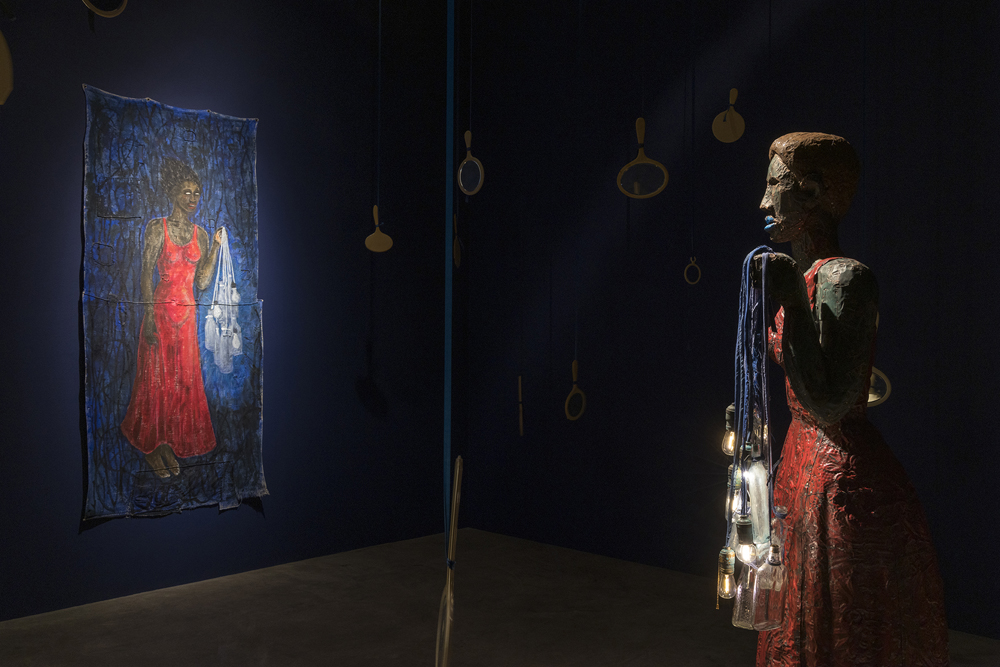
Installation view of SeenUNseen, curated by Alison Saar, L.A. Louver, November 11, 2021 – January 9, 2022. Courtesy of L.A. Louver, Venice, CA.
VH: The concept of spirit photography is a center point of the works in SeenUNseen. It’s a practice that emerged in the early 20th century as a means to capture remnants of the spirit world, or the netherworld, on film. How has your interest in this practice emerged, and how do you feel that the artists involved are channeling it into the present?
AS: I think there is only one artist who hit on spirit photography specifically, Kathy Grove. I’ve always been intrigued by spirit photography, and this idea of a tool that’s supposed to be all about truth and proof. There is real spirit photography, and then there is what’s considered charlatan spirit photography. But I think what’s wonderful is that charlatan spirit photography still served a purpose as a tool to help people heal, people in grief and desperately reaching out for closure, and this tool allowed them to cross that bridge.
The story about Kathy’s pieces is amazing: she was visiting her mother and they were packing up her grandmother’s house and she found a cigar box of blank pieces of celluloid film. At first, they looked blank, but she kept looking and saw this really faint image. She used digital media to enhance the film and, slowly, these two little girls’ faces started appearing in this strange Gothic living room. It turned out they were her mother and her aunt as little girls… Her work is really wonderful and was shown a lot in the 80s when she was making photos and retouching women out of classical paintings, like John Singer Sargent’s painting Portrait of Madame X—this sort of erasure of the muse. Those are really powerful in terms of the role women were allowed to play in this work, and that there were women painting these paintings but nobody was seeing them. They’re unseen. It’s interesting that she uses these digital tools and technology to reach back to what felt to me like really early photography tools and trickery.
And Keisha Scarville’s photographs go back to the idea of spirit material and objects through her mother’s clothes. The patterns told us so much about who her mother was. I loved that her personality and all of that was enclosed in these objects from her closet. So, between Keisha’s and Kathy’s work, those are the only actual photographs in the show. Prior to that, it was always painting, right? That was our tool before we had the camera. And again, this idea that a reality can be depicted and preserved in a certain way, it’s interesting when we start preserving things that aren’t visible or aren’t “reality,” right?
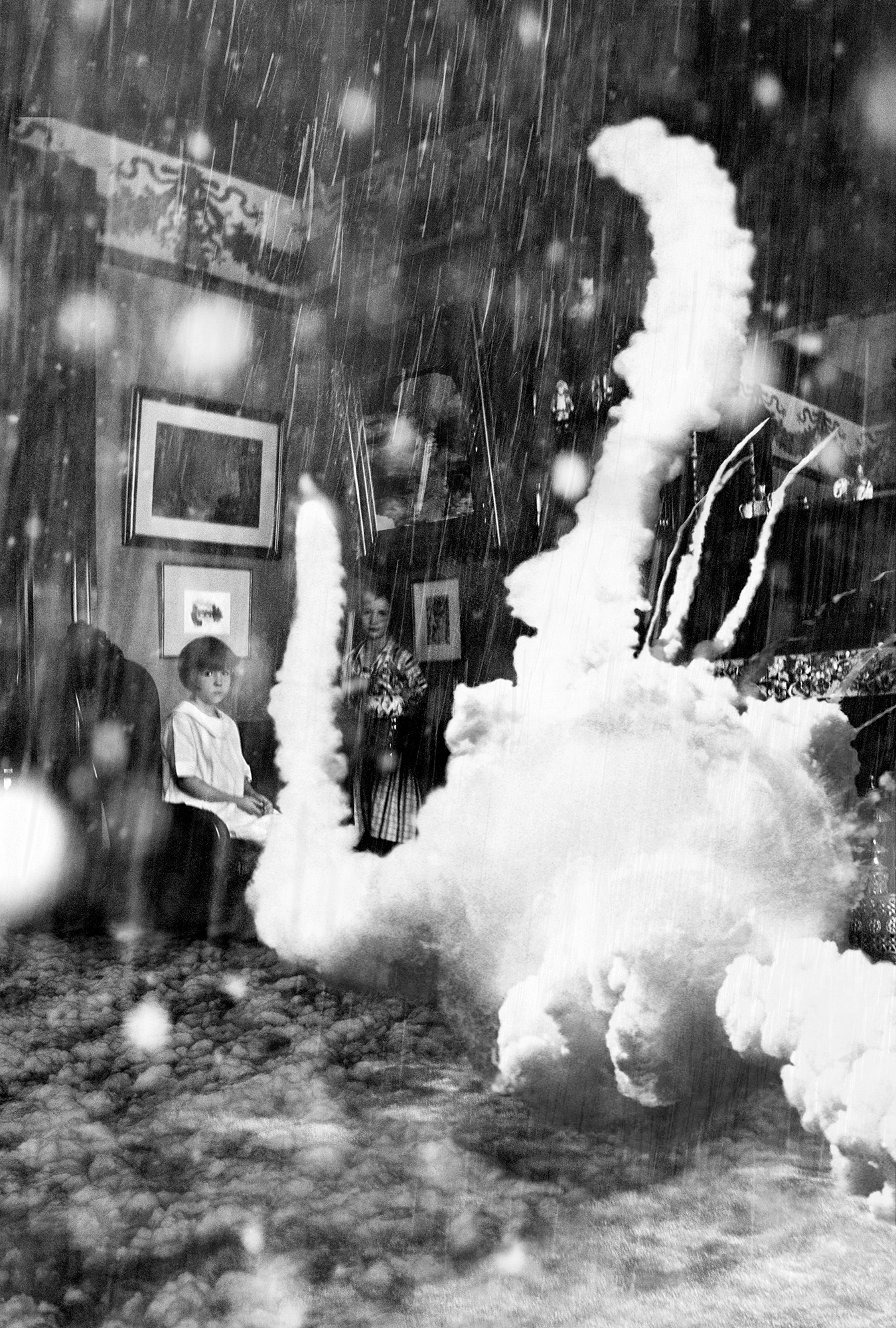
Kathy Grove, Erratics, 2011, archival pigment print, 37 1/4 x 25 1/8 in. (94.6 x 63.8 cm). Courtesy of L.A. Louver, Venice, CA.
VH: Absolutely. To return to that quality of “unreality,” I’m always struck by this duality in your work: there’s this dreamlike quality on the one side, and often a deeper historical reference simultaneously. You are holding both in the same work. The historical references are often grounded in questions of identity, particularly Blackness and womanhood and the intersection of the two. Could you speak to your conceptual process, particularly how you apply research on these themes to the materials and imagery you work with?
AS: Sometimes the works start with an object or an event, historical or contemporary. For example, I did a lot of work on the Great Mississippi Flood and the inequities of the way African-Americans were treated in 1927 during this flood. What brought that moment in history to light was, of course, Katrina. You could put these images side-by-side: Katrina, where people are stranded on freeway overpasses and forbidden to cross the bridges by white communities on the other side, and images of African-Americans who were intentionally left on levees to keep them from leaving the farmlands which were all underwater. They were all sharecroppers, so they owed this huge debt. On one hand, it’s the history that brings these ideas to light. But these stories have historically always been told through white media whether it be the news or film or even history books.
I also wanted to really understand these incidents involved in the Mississippi River and its flooding, and the role of rivers in Africa and transatlantic cultures and the spirit of rivers and the deities and gods of rivers. You can find that in so many different cultures. What is our relationship with this river and with these river spirits that we’ve brought with us to the Americas? Some of these pieces ended up being about Mami Wata or Yemaya and how they can be benevolent spirits; on the other hand, they can be really dangerous—they can drown you. How we navigate nature and how nature was such a big part of African communities coming to the U.S. and how that’s still maintained in rituals and connections with nature; you think of river baptisms, and that it’s very close to a lave in Yoruba cultures. I think there’s always this historical component, but there’s also the story of how we survived those incidents and that history. Part of the survival of that history is the spirit, our own refusal to succumb.

Keisha Scarville, “Untitled #18″ from Mama’s Clothes series, 2017. Archival inkjet print, 24 x 36 in. (61 x 91.4 cm), Edition 2 of 5, signed, titled, and dated verso. Courtesy of L.A. Louver, Venice, CA.
VH: It’s a way of going beyond these overwhelming histories of violence and catastrophe, whether inflicted by nature or by humans. Spirituality can almost be a form of resistance, like an uprising against these forces of oppression or trials by nature. It allows us to keep ourselves in balance and fight back.
AS: Yeah, it creates this unbreakable bond with how you’re going to survive and keep your family going. Part of that bond is also an obligation to your ancestors to honor how far they’ve brought us. There’s always debt to pay for all those who have preceded and made today possible. Our roles now are to make a better future possible. So I can include these ancestors, not only African ancestors, but your mother, your grandmother, your great grandmother who scrubbed people’s floors, and some of them who are still scrubbing floors to pay for their kid’s education so the kid doesn’t also have to scrub floors. Our spirit and our tenacity is a huge part of our survival in dealing with those dark histories that we are presently experiencing, and in pushing beyond them. We have the ability to still call onto those spirits for strength.
VH: Both your work and SeenUNseen are overflowing with dualities between light and dark, black and white, materiality and spirit. But embedded in the mysticism of these works is this message of militancy and resistance. For instance, Vanessa German’s sculptures draw from diasporic craft and folklore traditions, but also use found objects embedded with derogatory imagery that reflects the violent, racist history of the U.S. Kenyatta Hinkle’s “unportraits” channel the presence of disappeared Black women in ghostlike swaths of black India ink. In your own work, there’s this duality between mystical traditions and considerations of racial violence and histories. I’m thinking of the piece En Pointe; it’s a bronze sculpture of a woman hanging upside down tied up by her feet, which simultaneously evokes the history of lynching in this country and the mystical figure of the hanged man (or woman) in the tarot tradition. So, how do you see this relationship between mysticism and activism in your work and in the show? Do you see the two as being separate or intertwined?
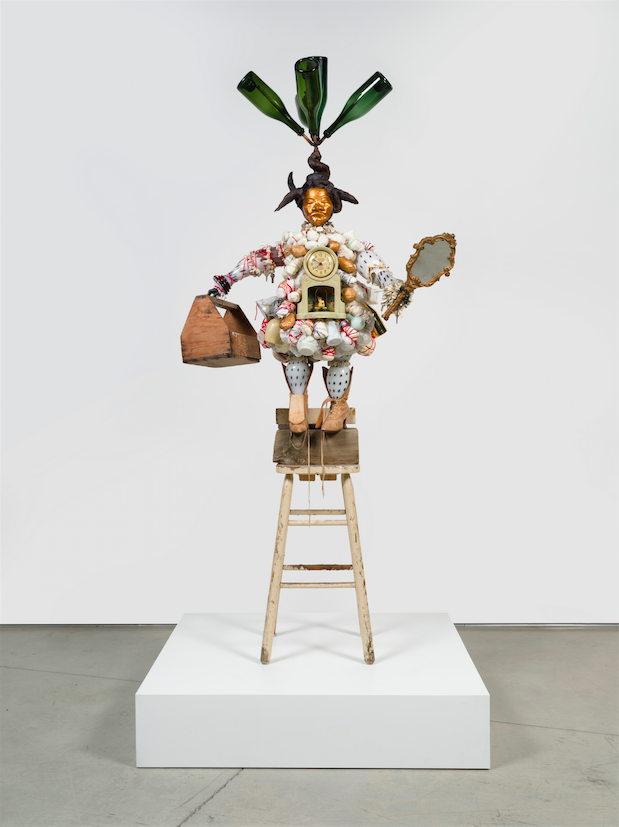
Vanessa German, Bottle Tree in my Body; Power figure to the simultaneous presence & pressure of the past, the present & the future, 2017, mixed-media assemblage, 87 x 36 x 30 in. (221 x 91.4 x 76.2 cm). Courtesy of L.A. Louver, Venice, CA.
AS: I think it’s definitely a tool we can use. To look at Kenyatta’s work specifically, she is channeling those figures—she uses these tools and brushes to invite the spirits to tell her stories, which I think is powerful and incredible. Her work is dealing specifically with unseen histories, even in terms of women who have disappeared through violence. I love that she’s offered her body and her mind and her materials up to these spirits to guide her and tell their story. Really, all these artists are opening doors for things to speak through them. This makes me think again of artists being conduits between two worlds, that somehow something from the other side is speaking through the work, which I know sounds really hokey, but I take issue with the idea of superstition because that implies it’s not real. That’s Euro terminology to say something is imagined or backwards.
VH: It’s reinforcing this false hierarchy between the intellect, which follows “logical” systems, and intuition—what we can perceive with our senses but haven’t yet been able to document by way of these more Western-approved approaches.
AS: I take offense to that false hierarchy. I’m a believer. I remember someone telling me once, ‘Never tell anyone you believe,’ because then you fall into this other category of naiveté, or of being uneducated. It’s important to give credit where it’s due and I feel that there’s definitely something out there—I wouldn’t say that I’m their voice, but I do feel like these pieces come to me. As an artist, it’s my role to put it out there and let it speak to whoever.
At art schools, it gets very cerebral sometimes. For me, my artistic process is very intuitive and emotional. Sometimes my mind is the last thing to catch up. You mentioned research, and I did some research on the work, but usually the idea behind the images comes first and then I have to go back and research… Sometimes I do research just to find out that I’m not putting something out there that is going to offend folks. Not so much that I’m censoring myself, but there’s so much going on out there that I can’t pretend to know everything that’s going on. I try to be careful that the work doesn’t somehow tap into something that shouldn’t be out there in the world. Part of my interest and my mother’s interest is looking at work from all over the world and trying to be respectful and not appropriating ideas or cultural things. I’m more interested in finding the connection between all of these worlds, so it’s not so much to take someone else’s ideas or rituals, but to see how they overlap.
VH: You brought up your mother and motherhood also comes across powerfully in your work, like in the Rouse piece at the Armory. Your mother, Betye Saar, and your daughter, Maddy Ines Leeser, are also artists. This matrilineal lineage of artists is so rare and inspiring. I’m curious if you feel that this lineage in your real life has shaped the way that you think about motherhood in your work.
AS: There’s no escaping it! I think that’s been a pivotal point in my work. When I was first starting, I was really interested in my mother’s history and ancestry. I had just moved to New York; my great aunt’s husband had a restaurant in Harlem, so I was intrigued with the Harlem aspect of our history, and then my mother’s family is from New Orleans, so I was intrigued with the Black diasporic traditions in New Orleans as well. But it wasn’t until I had my first child—just prior to him being born, I was like, who is this person? How is this going to work? Basically, where did he come from? (I didn’t know it was a boy at that time.) It’s kind of startling having a child—they put the baby in your arms and it opens its eyes and it’s just like, oh my God! This fully formed entity comes into your world. So that, again, made a real believer out of me that there is something going on, that you don’t come into this world devoid of anything, and you’re not just formed by your surroundings. Whether you’re carrying on from previous lives or what, I’m not sure, but you definitely arrive with an essence and a mission.
Being a mother really brought the spirit world and the intersection of it all front and center for me. I guess the work always parallels whatever trauma I’m going through with my family and kids… Rouse is really about having an empty nest—this nubile sort of semi-formed figure resting on her head. At one point I was thinking, it’s my daughter who’s going out into the world to become somebody. But it’s also me in that I am no longer functioning as this mother, no longer fertile, no longer nurturing. Who am I without my children? It was really kind of a crisis. I had to really think about what my function was.

Alison Saar, Rouse, 2012. Wood, bronze, paper, and antler sheds. Installation view of Alison Saar: Of Aether and Earthe at the Armory Center for the Arts, July 16 2021 to Dec. 12, 2021. This exhibition is co-organized with the Benton Museum of Art at Pomona College. Photo by Ian Byers-Gamber. Courtesy of Armory Center for the Arts.

Installation view of Alison Saar: Of Aether and Earthe at the Armory Center for the Arts, July 16 2021 to Dec. 12, 2021. This exhibition is co-organized with the Benton Museum of Art at Pomona College. Photo by Ian Byers-Gamber. Courtesy of Armory Center for the Arts.
VH: We don’t hear enough about artists who are also mothers.
AS: Artbound did an episode, “Artist and Mother.” Kenyatta Hinkle was one of the artists, and there was a group show at the Cleveland Museum of Art called Picturing Motherhood Now… I was lucky to have a mother who served as an example for me. My mother made art in the kitchen, and I’ve finally got another studio, but for most of my life, my studio was in my home. You just do what you need to do to make it happen.
VH: Even if you don’t have the sought-after “room of one’s own,” that Woolfian ideal of women having their own space for reflecting and producing creative work.
AS: And even if you don’t have the time! One of my favorite photographs is of Ruth Asawa working on one of her pieces. She’s sitting on the floor with a wire sculpture between her legs and a child beside her drinking a bottle butt-naked. She had a lot of kids, and she was just working while they were there reading, coloring, and drawing. But she managed to make this phenomenal work. When I see images like that it’s really empowering.
I think that’s kind of why we all became artists—my daughter as well—that’s the first language we learned, making stuff and drawing stuff, because that’s what we were around all the time, and materials were always available and accessible.
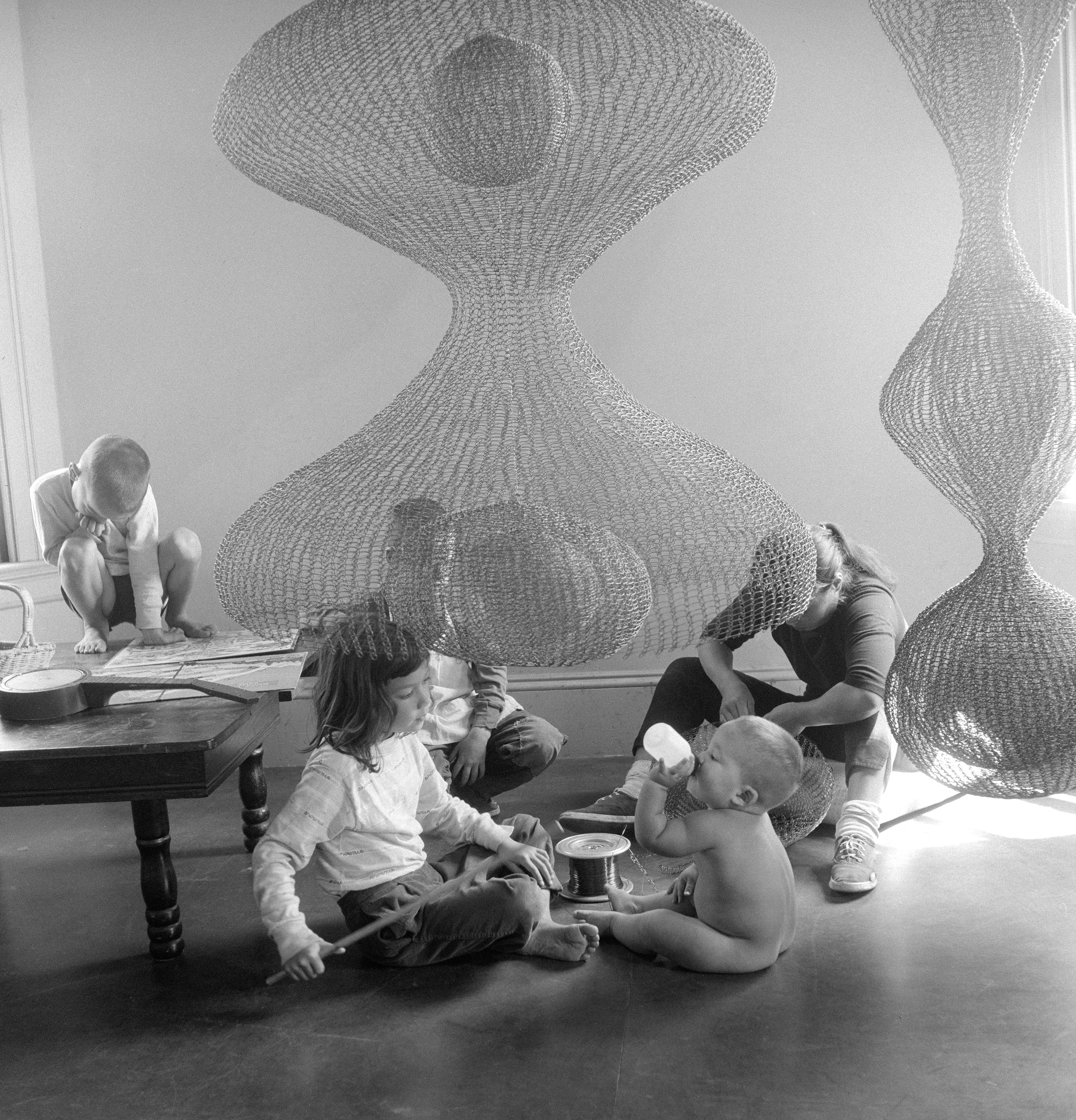
Artwork © 2022 Ruth Asawa Lanier, Inc./Artists Rights Society (ARS), NY. Courtesy of David Zwirner. © 2022 Imogen Cunningham Trust
VH: I noticed that a lot of the pieces in SeenUNseen, like Julia Haft-Candell’s sculptures, use techniques of binding, wrapping, weaving—also Arthur Simms’ sculptures, Keisha Scarville’s photographs, and JOJO ABOT’s acrylic and yarn textile pieces. This made me think of the relationship between weaving and other forms of domestic labor that have been traditionally delegated to women. Historically, so much of women’s labor has been invisible labor done behind closed doors. How do you understand these threads (no pun intended) of weaving and invisibility as they manifest throughout the exhibition?
AS: I think, historically, the idea of process in art has always been about intentionally making it invisible. The fine craftsman does not show the process at all. For myself, the work has always been careful to include the parts that have broken and been mended. Those histories of making are really important to what they are because they talk about the existence of the piece in and of itself. I’m intrigued with this idea of thread as a connection and as a binding, and that again goes back to the idea of conduit. A friend of mine from Mali once said, your work is the thread that leads to the word. And I love this notion that the art isn’t the thing, but the art is the means to get to the thing, so that it leads you to this next place. I love this idea that a fine thread, whether it’s a spider thread or a piece of string or a rope or piece of wire, it’ll lead you to another place.
My paintings at the Benton, those are all painted upon found sugar sacks that have been mended. I love how when something is damaged or torn, it can be repaired and then it has a new life. These are very common sort of negligible materials, but I think there are also political reverberations, repairing and taking these steps back, having to regroup and then push forward again. I think that’s just a good way to live life. I’m specifically interested in artists that are doing it. A piece of string doesn’t mean anything, but enough string tied together wraps the world.
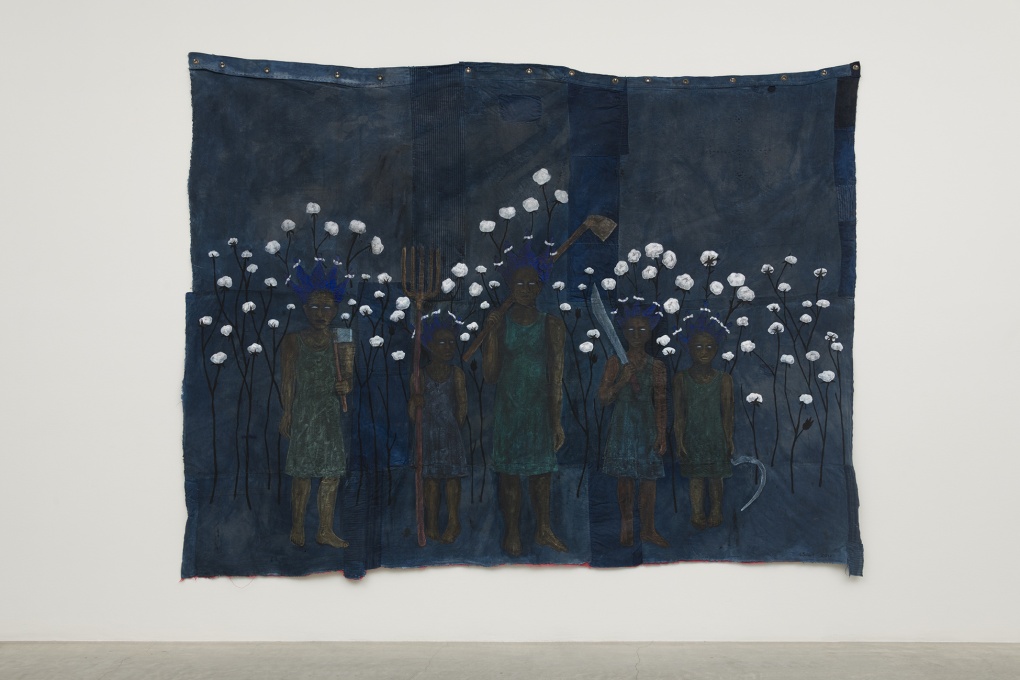
Alison Saar, High Cotton, 2017. Acrylic on indigo-dyed seed sacks, vintage linens, and denim. 84 x 102 in. (213.4 x 259.1 cm). Courtesy of L.A. Louver, Venice, CA.
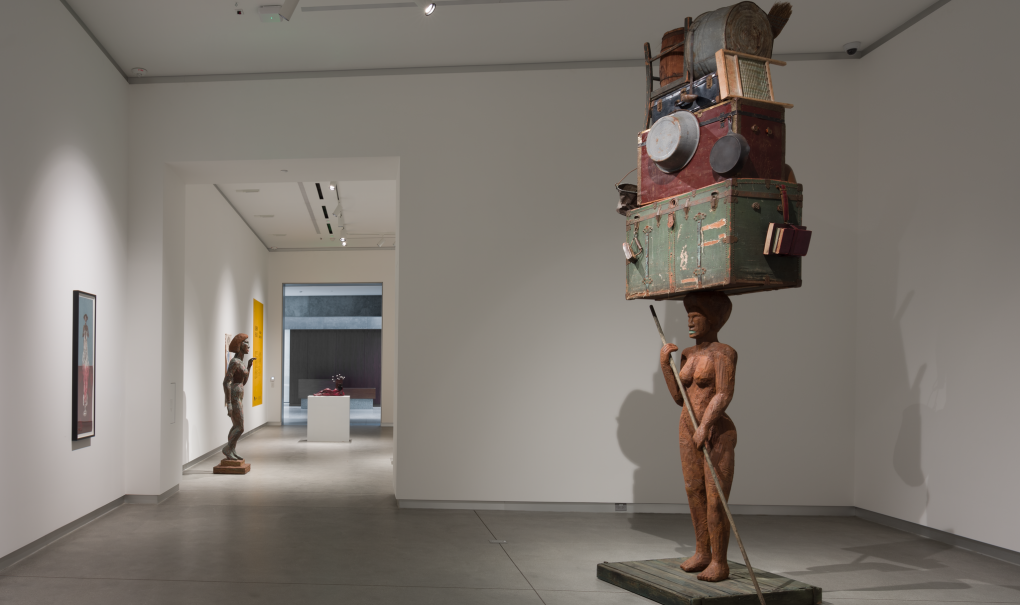
Installation view of Alison Saar: Of Aether and Earthe at the Benton Museum of Art at Pomona College, Sep. 1, 2020 – May 16, 2021. This exhibition is co-organized with the Armory Center for the Arts. Photography courtesy of Fredrik Nilsen Studio.
VH: I like the way thread as a medium can function as a metaphor, not only for the artist as conduit, but also like the spirit guides that we talked about earlier: the Hecate figure leading Demeter down to meet her daughter, Persephone—this idea of guidance between worlds can be embodied in thread as well.
I also want to ask about some of the other motifs in SeenUNseen. There are mirrors and jewels embedded in a lot of works in the show, jewels as forms of protection or visualization or as ritual objects. The press release mentions that the mirrors in both your and Vanessa German’s work evoke myths that see mirrors as tools for attracting spirits. The viewfinder in analog photography also functions by way of a mirror, which flips the image inside the camera body. So in a way, photography is also using a mirror to attract its spirits. Is that parallel, between the spiritual magnetism of photography and mirrors, something you considered when thinking about the practice of spirit photography (which arose largely in Europe) but then has this potential connection to non-Western mythologies?
AS: I hadn’t really put that together in terms of photography, but it’s also part of the process in printmaking, in that you always have to present something in its reverse. There are these dual worlds that simultaneously exist, one is sort of the mirror of the other. Some of this comes from reading and thinking about the work of Robert Ferris Thompson, who wrote Flash of the Spirit: African & Afro-American Art & Philosophy. He was looking at flash and light and reflection. … I’ve been looking at this Haitian Vodou flag that is embellished with sequins that bring light into the space similar to the way Southern bottle trees function, that flash and light is something that entices spirits into that space. It’s an invitation to spirits. Mirrors are often viewed as portals, so spirits can come through mirrors. You think of the role of mirrors in Dracula, where mirrors are truth-tellers wherein vampires don’t have any reflections, or you look at Yoshitoshi’s print The Fox-woman Kuzunoha Leaving her Child—the fox demon is this beautiful woman, but when she walks behind a screen you see only her shadow and realize who she really is. I think that’s interesting in terms of media and social media as well; it’s mirroring what’s going on out there and revealing things we may not be able to see with the naked eye. So, I’m really intrigued with this idea of bringing light to things both physically and metaphorically.
VH: The theme of magic is so pervasive in your work and in the show. How do you think magic and magical acts captured in art can create dialogue between the past and the future—to heal the past and also to imagine new futures?
AS: I think magic allows us to understand that there are possibilities that we never thought were possible. You’re doing something that’s impossible. When you think of how we’re going to transform the world as it is today into something that’s more benevolent and compassionate, a little magic definitely helps. That notion opens the door to possibilities because just living in the world and in total reality, feels so—it just feels so impossible. Especially when we’re experiencing what’s happening currently with voting rights and women’s reproductive rights—how we fought so long and so hard to get to this point and now it’s being unraveled from the other end. It’s just so frustrating and it’s easy to despair, to just say this is never going to change. But this notion of magic and using strength from another space where people can’t trod on everything you believe in gives us the energy and the will to push forward.